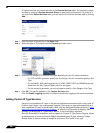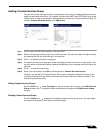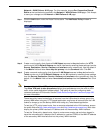
Network > Routing
327
SonicOS 5.8.1 Administrator Guide
Step 3 In the Advertise Default Route menu, select Never, or When WAN is up, or Always.
Step 4 Enable Advertise Static Routes if you have static routes configured on the SonicWALL
security appliance, enable this feature to exclude them from Route Advertisement.
Step 5 Enable Advertise Remote VPN Networks if you want to advertise VPN networks.
Step 6 Enter a value in seconds between advertisements broadcasted over a network in the Route
Change Damp Time (seconds) field. The default value is 30 seconds. A lower value
corresponds with a higher volume of broadcast traffic over the network. The Route Change
Damp Time (seconds) setting defines the delay between the time a VPN tunnel changes state
(up or down) and the time the change is advertised with RIP. The delay, in seconds, prevents
ambiguous route advertisements sent as a result of temporary change in the VPN tunnel status.
Step 7 Enter the number of advertisements that a deleted route broadcasts until it stops in the Deleted
Route Advertisements (0-99) field. The default value is 1.
Step 8 Enter a value from 1 to 15 in the Route Metric (1-15) field. This is the number of times a packet
touches a router from the source IP address to the destination IP address.
Step 9 If RIPv2 is selected from the Route Advertisements menu, you can enter a value for the route
tag in the RIPv2 Route Tag (4 HEX Digits) field. This value is implementation-dependent and
provides a mechanism for routers to classify the originators of RIPv2 advertisements. This field
is optional.
Step 10 If you wan to enable RIPv2 authentication, select one of the following options from the RIPv2
Authentication menu:
• User defined - Enter 4 hex digits in the Authentication Type (4 hex digits) field. Enter 32
hex digits in the Authentication Data (32 Hex Digits) field.
• Cleartext Password - Enter a password in the Authentication Password (Max 16 Chars)
field. A maximum of 16 characters can be used to define a password.
• MD5 Digest - Enter a numerical value from 0-255 in the Authentication Key-Id (0-255) field.
Enter a 32 hex digit value for the Authentication Key (32 hex digits) field, or use the
generated key.
Step 11 Click OK.
Route Policies
SonicOS Enhanced provides Policy Based Routing (PBR) to provide more flexible and granular
traffic handling capabilities. The following sections describe PBR:
• “Policy Based Routing” on page 328
• “Route Policies Table” on page 328
• “Static Route Configuration” on page 329
• “Probe-Enabled Policy Based Routing Configuration” on page 330
• “A Route Policy Example” on page 330


















